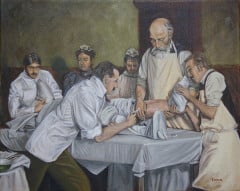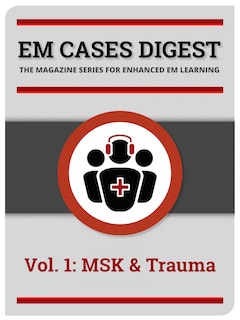Dr. Dave MacKinnon & Dr. Mike Brzozowski return for an Update in Trauma Literature since the epic Episode 10: Trauma Pearls & Pitfalls. In this episode we discuss predicting the sick trauma patient, videolaryngoscopy vs traditional laryngoscopy, Damage Control Resuscitation, Occult Hemothorax, Blunt Thoracic Aorta and Cardiac Injury, Sternal Fractures, Tranexamic Acid, Communication in the trauma bay and much more……
Written Summary and blog post by Claire Heslop, Edited by Anton Helman, December 2013
Cite this podcast as: MacKinnon, D, Brzozowski, M, Helman, A. Update in Trauma Literature. Emergency Medicine Cases. December, 2013. https://emergencymedicinecases.com/episode-39-update-trauma-literature/. Accessed [date].
Predicting the Sick Trauma Patient
One Drop in BP
- A single hypotensive episode in polytrauma, including prehospital BP, predicts a poor outcome [Bilello, 2011]
- In patients with SBP < 105, 38% required immediate OR/angio vs. 10% with SBP between 105-110 [Seamon, 2010]
Predictive Lab Values
- Base Deficit (BD), Lactate, Hematocrit
Identifying the ‘Crump Factor’ Rule SBP -6… consider no CT & direct to OR [Bilello, 2011]
- ABG vs. VBG: good correlation between the two in polytrauma although studies conflicting
- Serial hematocrit: may be useful but not as predictive as serial lactate
- Serial lactate: patients who clear lactate slowly may have occult hypoperfusion
ETCO2
- In penetrating trauma: higher ETCO2 via nasal cannula correlates with serum lactate and need for surgical intervention [Caputo, 2012]
IVC Flatness
Flat IVC on CT (defined as a infrarenal transverse to anteroposterior IVC ratio of 1.9) was an independent predictor of mortality [Johnson, 2013]
IV Bicarb in The Acidotic Polytrauma Patient Increases Mortality
Retrospective study of 225 severely acidotic trauma patients, with a pH less then 7.10. Bicarbonate increased HCO3- and PaCO2. PaCO2 rise was associated with increased risk of mortality. In the acidotic patient, fluid resuscitation, inititating massive transfusion protocols if necessary, and transfer to OR/angio continue to be the most important resuscitative measures.
Video vs Direct Laryngoscopy in Trauma
- RCT (single centre, 623 adults) of video laryngoscopy compared to direct laryngoscopy showed:
- No mortality difference
- Severely head injured patient mortality: 30% with video vs. 14% with direct laryngoscopy
- Intubation time (average): 56 sec with video vs. 40 sec with direct laryngoscopy
- Desaturation below 80%: 50% with video vs. 23% with direct laryngoscopy
Damage Control Resuscitation
DCR has 5 components
- Avoiding hypothermia
- Permissive hypotension
- 1:1:1 RBC:FFP:PLT transfusion
- Coagulopathy correction
- Damage control surgery
Evidence for Permissive Hypotension? Moderate evidence in penetrating trauma for a short period of time (i.e. during bridge to OR). No evidence for blunt trauma.
1:1:1 Transfusions PROMMTT Study: decreased 6h mortality with increased ratio of plasma:RBC and RBC:platelets. In the first 6h, patients with ratios less than 1:2 were 3-4 times more likely to die than patients with ratios of 1:1 or higher. Identifying patients who may require activation of massive transfusion protocol [Hsu, 2013]:
- Base deficit > 5 and
- INR >=1.5 and
- Hemoperitoneum
Update 2015: PROPPR trial in JAMA compares transfusion of platelets, plasma and RBC in a 1:1:1 vs a 1:1:2 ratio. Full Article
Scott Weingart discusses the PROPPR trial with it’s lead author John Holcomb on EMCrit
Interpretation of the PROPPR trial on EM Literature of Note
Thromboelastometry (TEG/ROTEM) May help guide hemostatic resuscitation by measuring of the visco-elastic properties of blood as it clots.
- Shows interaction of platelets with the coagulation cascade.
- Generates graphical and numerical output.
- Fast turnaround
Fluid Resuscitation ATLS update: start with 1L crystalloid bolus instead of traditional 2L, to emphasize a switch to blood products early. Greater than 1.5L crystalloid to 1unit PRBC ratio has been showed to be related to an increased incidence of ARDS, abdominal compartment syndrome, multi-organ failure. No difference in mortality [Neal, 2012].
Imaging Decisions in Trauma
C-Spine Imaging: What’s a ‘Distracting Injury’? Distracting injury is trigger to imaging as per NEXUS criteria. Study from 2012 (10) showed that in patients with a GCS of 14-15 with a distracting injury, clinical exam picked up 85 of 86 C-Spine injuries. [Rose et al. 2012. J Trauma Acute Care Surg: 73(2): 498-502.]
Chest Imaging Decisions CT chest usually done if concern of thoracic spine or aortic injury
SCRAP Rule – Indications for chest CT in blunt trauma [Payrastre, 2012]. Retrospective study of 434 patients with GSC >8 , ISS score >12, all had CT at admission. Rule consists of: S(saturation) C(CXR) R(Resp Rate) A(Auscultation of chest) P(Palpation of chest). If O2 sat normal (95% RA or 98% with supplemental O2), normal or unchanged CXR, RR =<25, Chest auscultation normal, Palpation of chest normal = 100% sensitivity and NPV for major thoracic injuries. Our experts believe this rule adds little to clinical judgement.
Occult Hemothorax – not seen on CXR, seen on CT. In a 2012 study of 81 patients with occult hemothorax followed clinically., 83% could be managed without chest tube [Mahmood, 2011].
Pan-Scanning Trauma Recent study (2013) showed that chest-abdo-pelvis CT in the initial evaluation of blunt trauma compared to clinical exam with FAST examination did not result in mortality difference, missed injuries or delay to diagnosis.
Found Down Patient Urban level 1 Trauma centre, 201 patients ‘found down’, includes intoxicated, psychiatric , homeless patients. 40% had injuries, 4.5% required urgent surgical intervention [Kornblith, 2013].
Blunt Aortic Injuries
CT Chest should be done if suspect aortic injury.
Suspicion of aortic injury based on mechanism of injury (i.e. high energy, including lateral impact pelvic fractures, anteroposterior deceleration, fall from height).
Our experts recommend that in low risk mechanism with low clinical suspicion can use CXR for screening. Normal CXR has a 98% NPV for blunt aortic injury.
Management: treat medically first, manage BP, coagulopathy, hypothermia. Surgical treatment once patient is stable, unless the patient is unstable from an aortic injury.
Blunt Cardiac Injury
Includes myocardial contusion, free wall rupture, valvular injury and pericardial injury.
Suspect in any high mechanism blunt, crush or deceleration injury to the chest.
Start work-up with CXR, FAST & ECG
Role of ECG, troponin and Echocardiogram:
- ECG: with normal ECG, risk of complication from myocardial contusion is low. Observe or discharge. Newer guidelines, consider troponin. Normal ECG with normal trop, observe and discharge.
- Troponin: no consensus on timing of troponin or what to do with a positive Trop; poor sensitivity. Consider Echocardiogram in stable patients with positive Trop.
Sternal Fractures
Patients with isolated sternal fractures, a normal ECG & CXR and normal vital signs are at low risk for requiring intervention, and can be safely discharged [Odell, 2013].
Traumatic Aortic Injury
TRAINS Score (TRaumatic Aortic INjury Score)
Predicting aortic injury in trauma:
- Widened mediastinum (4 pt)
- BP < 90 (2 pt)
- Long bone fracture (2 pt)
- Pulmonary contusion (1 pt)
- Left scapular fracture (1 pt)
- Hemothorax (1 pt)
- Pelvis fracture (1 pt)
Score >= 4 high risk
For more information on trauma on EM Cases:
Episode 10 Part 1: Trauma Pearls and Pitfalls
Episode 10 Part 2: Trauma Pearls and Pitfalls
Best Case Ever 60 What we can learn from Prehospital Trauma Management
Ep 118 Trauma – The First and Last 15 Minutes Part 1
Ep 119 Trauma – The First and Last 15 Minutes Part 2
Best Case Ever 20: CPR in Trauma
References
- Bilello et al. 2011. J Trauma: 70(5):1038-42.
- Seamon et al. 2010. J Trauma: 68:1289-95.
- Caputo et al. 2012. J Trauma Acute Care Surg: 73(5):1202-7.
- Johnson et al. 2013. J Trauma Acute Care Surg: 74:741-6.
- Wilson et al. 2013. J Trauma Acute Care Surg: 74:45-50.
- Yeatts et al. 2013. J Trauma Acute Care Surg: 75:212-9.
- Neal et al. 2012. J Trauma Acute Care Surg: 72(4):892-8.
- Holcomb et al. 2013. JAMA Surg: 148(2):127-36.
- Hsu et al. 2013. J Trauma Acute Care Surg: 75:359.
- Rose et al. 2012. J Trauma Acute Care Surg: 73(2):498-502.
- Payrastre et al. 2012. CJEM: 14(6):244-53.
- Mahmood et al. 2011. Am J Surg: 201:766-769.
- Sise et al. 2013. J Trauma Acute Care Surg: 74:92-9.
- CRASH-2 Collaborators. 2011. Lancet: 6736:60278.
- Morrison et al. 2012. Arch Surg: 147(2):113-9.
- Kornblith et al. 2013. J Trauma Acute Care Surg: 74:1548-52.
- Odell et al. 2013. Trauma Acute Care Surg. Sep 75:448
Dr. Helman, Dr. MacKinnon and Dr. Brzowski have no conflicts of interest to declare.
For more on Trauma Bay Pearls & Pitfalls download free eBook EM Cases Digest Vol.1 MSK & Trauma







Leave A Comment